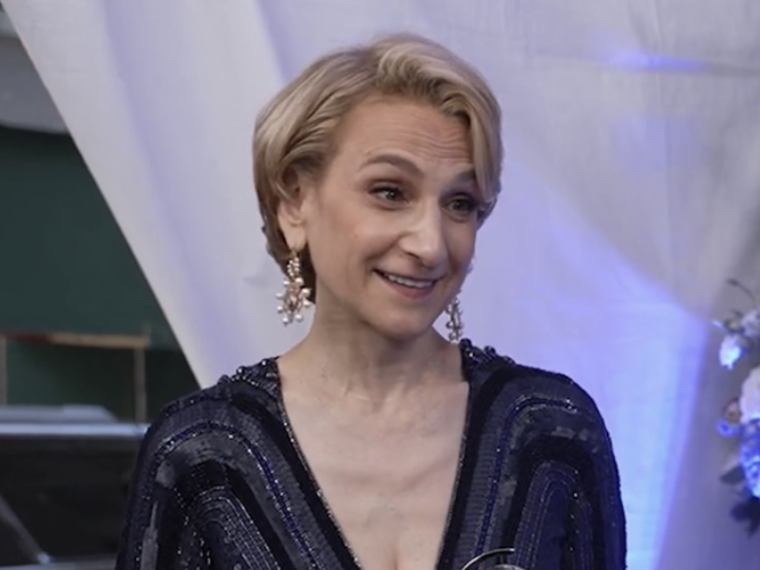Lighting the Way
June 8, 2023
Maura Johnston

At the 76th Tony Awards, Natasha Katz ’81 faced a formidable opponent —herself. The lighting designer, who received an honorary doctorate of fine arts at Oberlin’s 2023 commencement ceremony, was nominated twice in the Best Lighting Design of a Musical category for her work on the brand-new adaptation of Some Like It Hot and the Josh Groban-led revival of Stephen Sondheim’s Sweeney Todd: The Demon Barber of Fleet Street.
This wasn’t the first time Katz faced off against herself at Broadway’s annual awards ceremony: In 2012, she had another adaptation-Sondheim double dip when she was nominated in Best Lighting Design of a Musical for her work on the street-musician love story Once and the early ’10s revival of Sondheim’s nostalgia trip Follies. That year, she won for Once—and at the June 11, 2023, ceremony, she won for Sweeney Todd, bringing her total of Tonys won to eight.
Overall, Katz has designed the lighting for more than 60 Broadway productions—including the current Broadway run of the thriller Grey House, as well as Springsteen on Broadway; Frozen; Hello, Dolly!; The 25th Annual Putnam County Spelling Bee; and the inaugural Beauty and the Beast—in addition to dance performances, operas, and two Niketown outposts.
Katz became entranced by Broadway at an early age. “My parents took me to the theater all the time,” she says from her home in her native New York. “My mother always said I was born to work in the theater, and then my graduation present from high school was eight shows in a week.”
“Until I got to Oberlin, I didn't even know what a stage manager did. I didn't know how a show was put on. It was all from the point of view of the audience member—you snapped your fingers and somehow there's a show in a theater.”
Katz was drawn to Oberlin by the school’s progressive atmosphere and liberal arts foundation, as well as the town’s contrast to New York’s metropolitan bustle. But after arriving on campus, she initially kept theater as her “own private, happy thing” and wound up majoring in French instead.
Her introduction to the school’s theater department came via the History of Western Theatre course with Roger Copeland. The class opened her eyes to the work behind the spectacles that had dazzled her as a youth. “Until I got to Oberlin, I didn't even know what a stage manager did. I didn't know how a show was put on,” she recalls. “It was all from the point of view of the audience member—you snapped your fingers and somehow there's a show in a theater.”
She eventually began working in the scene shop, and a student director asked her to light a production of Harold Pinter’s The Dumb Waiter. “I thought, ‘Oh, this is kind of fun,’” she says. “I didn't even know what lighting was.”
Taking a class in lighting led to her spending a semester in New York through the Great Lakes College Association. There, she met lighting designer Roger Morgan, who quickly became her mentor. “Roger took me everywhere,” she says. “When we talk about mentorship, he was an incredible mentor. I was in every single meeting with him, so I started to understand a little bit about what the business was. I tell people that I became a lighting designer through on-the-job training.”
She remained in New York and “kept getting work and getting work and getting work,” she says, leading to her taking a leave of absence from Oberlin and jumping right into her career. Katz has watched the discipline of lighting evolve over the last four decades, from the then-cutting-edge computerized boards of her early work to the robotic spotlights that open more of the stage to today’s productions. “You used to have to get on a ladder to focus a light to a certain place—then it was stationary, and it had to be in that one spot,” she notes. “Now, all of that can be controlled remotely.”
Katz’s approach to lighting is directly connected to her time at Oberlin in the 1970s. Back then, she was encouraged to think of art as a series of interconnected disciplines as a student in Oberlin’s Inter-Arts Program. This program brought together students working in a variety of disciplines so they could, as the mission statement put it, “probe that which is unknown and see the familiar in a new way"—a mindset also present today with Oberlin's integrated concentrations.
Lighting is, of course, key to seeing anything—and Katz takes every aspect of a production into consideration when she’s designing a lighting setup. Whether it’s an elaborate one, like Disney’s 1990s reimagining of Beauty and the Beast, or a single-performer venture like Springsteen on Broadway, she digs into a production’s details, all the way down to the fabric and materials used in the costumes and sets.
“There are costumes which are different colors, different materials, and those take light in different ways,” she says. “The scenery—all the same things, different materials. Some reflect light, some absorb light.” Figuring out the vagaries of a set’s fundamentals is just the first step—then there’s navigating the sometimes-copacetic, sometimes-conflicting visions of the director, the set designer, and other people who might be invested in the meaning and look of what’s on stage.
“The lighting designer has to take all these aspects and pull them together,” she says. “If you pull that all the way back to Inter-Arts, it’s the same thing.”
Tags:
You may also like…
Four Distinguished Alums to Receive Honors at Oberlin's 2025 Commencement
April 30, 2025
These prestigious recipients are being recognized for their academic impact and community service.
Five Oberlin Alumni Earn 2025 Guggenheim Fellowships
April 25, 2025
Five Oberlin alumni have been awarded prestigious Guggenheim Fellowships.
Sonia Shah ’90 to Deliver Commencement Address to Class of 2025
April 15, 2025
Sonia Shah ’90, an investigative journalist and critically acclaimed author, will deliver the keynote address for Oberlin College and Conservatory’s Commencement ceremony honoring the Class of 2025 on Monday, May 26.


